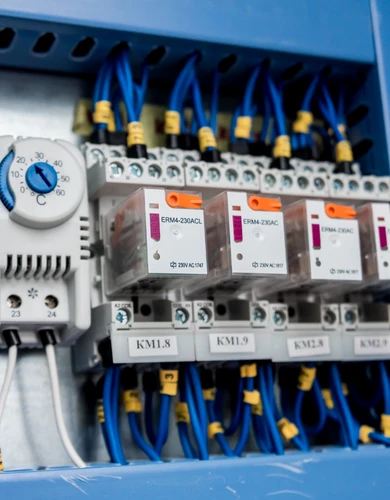BSUoS charges for businesses
BSUoS charges account for approximately 3% of domestic and business electricity prices. These charges cover the cost of maintaining balance on the national grid, ensuring a stable and uninterrupted electricity supply.
BSUoS charges fund the National Energy System Operator’s vital role in maintaining voltage and frequency stability on the grid, preventing infrastructure damage and avoiding blackouts.
This guide explains the balancing activities funded by BSUoS charges and their impact on domestic and business electricity bills.
What are BSUoS charges?
The acronym BSUoS stands for Balancing Services Use of System. BSUoS charges represent the costs associated with the National Energy System Operator (NESO) in balancing supply and demand on the national grid.
Below, we’ve summarised the four balancing activities provided by NESO that contribute the most to overall BSUoS charges.
Market balancing mechanism
NESO continuously forecasts electricity demand using weather data, historical trends, and market information to predict peaks and troughs in electricity usage.
NESO collaborates with electricity generators to schedule increases or decreases in output, ensuring that forecasted demand matches generation.
Gas power stations and Drax’s biomass power plant typically provide these balancing services as they can dynamically adjust electricity generation. NESO pays participating generators to modify their planned power output as needed.
NESO also pays for demand-side balancing services through schemes such as the Demand Flexibility Service, which compensates industrial energy users for voluntarily reducing their electricity consumption during peak times.
Short term balancing
Short-term balancing ensures there is sufficient backup capacity to address unexpected increases in demand or sudden losses in generation.
NESO contracts with reserve capacity providers to supply power that can be activated at short notice. A prominent example is the Dinorwig pumped hydroelectric facility in North Wales, which stores water at a high elevation and releases it to generate electricity when requested by NESO.
Frequency response
NESO is responsible for maintaining the national grid’s frequency at 50Hz. Deviations from this frequency could result in widespread electronic equipment failure.
Renewable energy sources, such as wind and solar, do not use spinning turbines and therefore provide a less stable frequency output. As the UK transitions towards Net Zero, the importance of frequency response services continues to grow.
National Grid ESO contracts with generators and energy storage providers to deliver these vital services.
Winter security of supply
Since the start of the war in Ukraine, NESO has also been responsible for ensuring a contingency fuel supply during the winter months.
In the event of supply shortages, NESO can:
- Make independent purchases of LNG to provide a backup supply for gas-fired power stations.
- Cover coal procurement costs to activate coal-fired power stations as an alternative to gas-fired power stations.
BSUoS charges 2025/26
Unlike other network charges, such as DUoS and TNUoS, BSUoS tariffs are straightforward. A single fixed unit rate per kWh applies to all electricity users.
Domestic and business energy suppliers incorporate BSUoS charges into their unit rates, which are then paid to the National Energy System Operator.
For the 2025/26 year, the BSUoS tariff is 1.496p/kWh. This equates to approximately £40 per year for the average British home and contributes around 3% to overall business electricity rates.
💡Suppliers typically charge a margin on top of BSUoS charges. Find the most competitive tariffs with our business electricity comparison service.
Fixed tariff method for BSUoS charges
From 1 April 2023, Ofgem implemented a significant change to simplify the way BSUoS charges are collected.
Ofgem’s modifications, formally known as CMP308 and CMP361, introduced the following changes:
- BSUoS charges, which were previously levied on both generators and consumers, are now charged to consumers only.
- Previously, BSUoS charges fluctuated regularly based on actual balancing costs incurred by NESO. The modifications introduced a fixed tariff for BSUoS, set in advance, providing suppliers with greater certainty over charges.
Rising BSUoS charges
In 2019 BSUoS charges were on average 0.6p/kWh, less than half of the current tariff. The overall cost of balancing the national grid has increased significantly over the past few years.
| Year | Total BSUoS Costs (£ billion) |
|---|---|
| 2025/26 (estimate) | 1.9 |
| 2024/25 | 1.7 |
| 2023/24 | 1.8 |
| 2022/23 | 2.8 |
| 2021/22 | 2.4 |
| 2020/21 | 1.3 |
| 2019/20 | 0.9 |
Source: neso.energy – Balancing costs
The increase in BSUoS costs is primarily due to the following two recent developments.
Rising wholesale electricity prices
BSUoS charges fluctuate with underlying wholesale electricity prices because balancing the grid requires paying electricity generators to adjust their output, either by providing additional power or reducing supply. These payments are made at rates closely tied to the market price.
When wholesale electricity prices rose significantly in 2021 and 2022, the cost for National Grid ESO to procure balancing services also increased.
Decarbonisation of the grid
The fuel mix of the national grid is evolving as the government and Ofgem drive progress towards the net-zero target of 2035. Decarbonisation of the grid is making balancing supply and demand more complex and expensive.
The contribution of wind farms in the UK to electricity generation is steadily increasing. Wind farm output is weather-dependent, fluctuating unpredictably, increasing the volume of balancing activities required to maintain grid stability. Simultaneously, two large-capacity nuclear power plants, Hinkley Point and Sizewell C, are under construction, adding further challenges to balancing the grid. While nuclear power plants produce stable and reliable electricity, they lack the flexibility to adjust their power output rapidly.
As the grid transitions away from reliance on fossil fuels, the number of facilities capable of providing balancing services is decreasing.
In response, NESO is exploring demand-side response mechanisms to support a more flexible energy grid.

